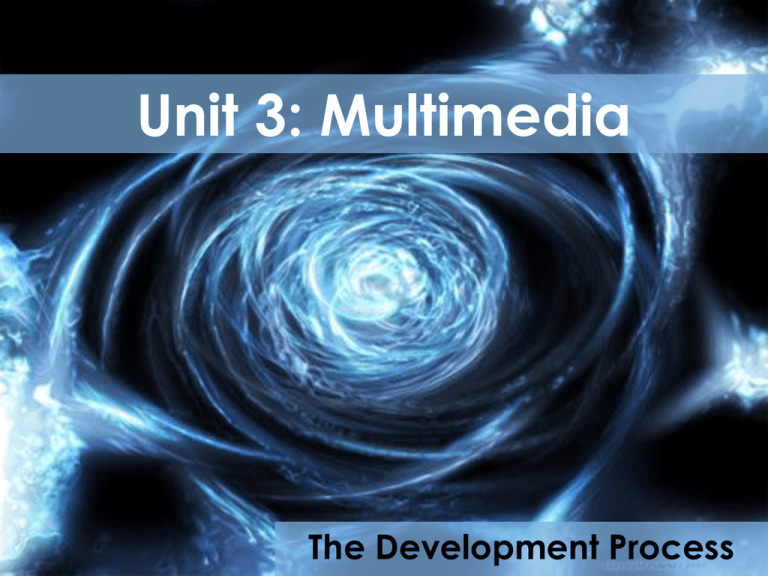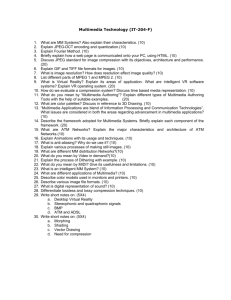Topic 1
advertisement

Unit 3: Multimedia The Development Process What is Multimedia? • An interactive piece of software using several types of media: – – – – – Text Graphics (photographs or illustrations) Audio (synthesised or digitised) Video Animation • Multimedia Applications can be: – Linear or non-linear – Simple or extremely complex – For example: • PowerPoint presentation • Sophisticated and basic web pages • Multimedia games The Development Process/Cycle Analysis Design Design may change if application does not work as expected Implementation Testing Documentation Evaluation Maintenance Analysis Stage • This stage is make it absolutely clear what the project is supposed to do. – – – – – – – The aims of the application Who will be using it? What will be in it? How will it be distributed? How much money can be spent? How long have you got? Input/output? • At the end of the stage a requirements specification will be produced. Design Stage • • • • Navigation structure? The HCI (Human Computer Interface) What does each screen look like? What media elements will be included? Storyboards may be produced for this. Implementation Stage • Make it: – Create and combine all the media elements using the pre-decided authoring software. Testing Stage • Does each screen and link work as expected? – If not can it be fixed or does it have to have the design altered. Documentation Stage • Write the documentation: – The technical guide • What are the hardware requirements – The user guide • Advice on how to use the software and provide users with any other help. Evaluation Stage • Does it meet the specifications made at the analysis stage? Maintenance Stage • Fixing any bugs that have been found after its released. • Adapting and updating the application to suit clients needs. Unit 3: Multimedia The Development Process The Development Process Mnemonic Analysis Design Implementation Testing Documentation Evaluation Maintenance A Dance In The Dark Every Monday Methodologies used in creation of multimedia applications Text editor: • Application is created using plain text – e.g. Creating simple web pages using HTML. WYSIWYG editors: • Previewing applications under development to check that What You See Is What You Get. – Eg PowerPoint to create a presentation WYSIWYG Text Editor WYSIWYG Vs Text Editors Advantages Text Editor WYSIWYG Simple and places less demands on system. Disadvantages Difficult to Visualise output Provides greater control over the application Dependant on programming or text-based commands knowledge Easy creation and editing of application Complex software that puts higher demands on system. Ideal for beginners Software tends to be expensive Methodologies used in creation of multimedia applications Authoring Software • Application can be customised using: – Program code or scripting – Icon based setting up of properties (without the need to learn programming code) Presentation Software • Enables the creation of a sequence of slides • Allows hyper linking to different slides or files Methodologies used in creation of multimedia applications • Who makes authoring software? – Macromedia • Flash, Dreamweaver and Director – Microsoft • FrontPage – Adobe • GoLive – Others • Mediator, HyperStudio, etc Methodologies used in creation of multimedia applications • Who makes presentation software? – Microsoft • PowerPoint (Most common) – Others • LiquidMedia • Cre8 • Many others exist but not common Authoring Vs Presentation Authoring Presentation Advantages Disadvantages Advanced features give developer more control over final application Difficult to learn, special training generally required Simple commands Limited features Easy to learn Can be difficult to debug complex application Unit 3: Multimedia The Development Process Displaying Multimedia Data Distribution Technologies • Web Pages • Embedded into Web pages – – – – ActiveX Object Visual Basic Script Java Applet JavaScript Program Displaying Multimedia Data Distribution Technologies (cntd) • Stand alone Program (executable) • Multimedia file using player software – Macromedia Flash or Shockwave – PowerPoint – QuickTime Displaying Multimedia Data Distribution Medium • • • • • Web pages on the Internet Web pages on an Intranet CD-ROM DVD Digital Broadcast System Displaying Multimedia Data Embedded Data • Applications include files for sound, video etc • These are combined (embedded) into the actual program file itself Advantages File management is easier as there is only one file Disadvantages File could be very large Entire file must be downloaded before it can be Easier to implement security played Individual data items cannot be updated separately Displaying Multimedia Data Streamed data • Data broadcast over a network – radio stations broadcast over the Internet – View film clips • Played as it is received • No need to download entire file before listening/viewing it • Requires a plug in e.g. Real Player Codecs & Container Files Codecs (Compressor/Decompressor) • Main purpose is to reduce the file size while keeping as much quality as possible • Enables faster downloads • Often built into programs but sometimes require downloaded as a add-in Codecs & Container Files Container File • Contains several compressed files. • This can be transmitted over a network and the individual files regenerated at the receiving end • Much more convenient than sending multiple files • A ZIP file is an example of a container file


